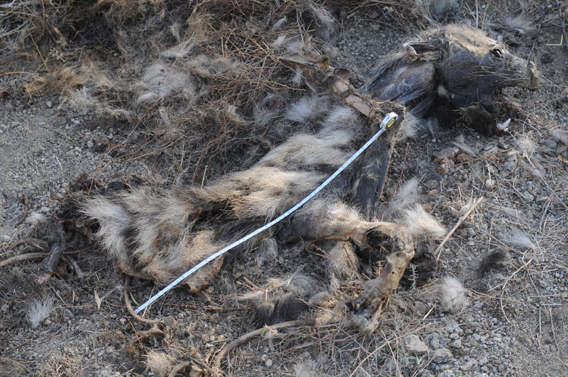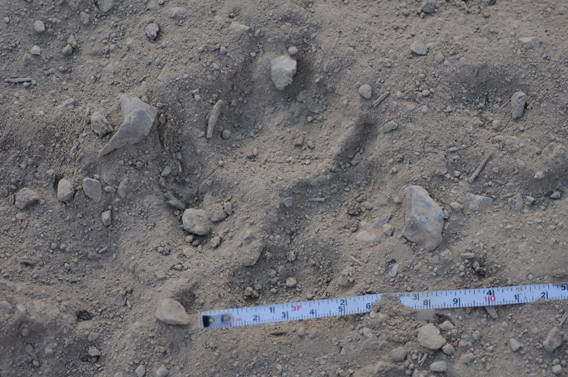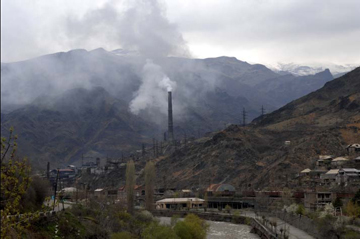On October 1, 2010, the carcass of a striped hyena was found entangled in barbed wire surrounding an orchard in southern Armenia. The find represents the nation’s first confirmed hyena observation in over 60 years.
Although they may be doglike in appearance, hyenas are actually more related to cats than dogs, with their closest relatives being the meerkats and mongooses. The striped hyena is one of the smallest true hyena species and retains many primitive features not found in larger species. It is preferentially a scavenger, but hunts on occasion. The striped hyena is native to North and East Africa, the Caucasus, the Middle East, and Middle, Central and Southern Asia. It is listed by the IUCN as Near Threatened, with an estimated total wild population of less than 10,000 mature individuals, and is expected to decline a further 10 percent within the next three generations primarily due to habitat loss.
In Armenia, the last reliable sighting of a striped hyena occurred in the late 1940s when an individual was observed in the vicinity of the capital city of Yerevan, with the last scientific record occurring in 1925 in the western portion of the country. The major cause of the species’ extirpation from Armenia was the almost complete conversion of suitable hyena habitat into cropland.
World Wide Fund for Nature (WWF) researchers discovered the striped hyena carcass in October during a routine leopard monitoring survey. While scavenging had taken place, enough of the skeleton was present for scientists to confirm species.
 Striped hyena corpse entangled in barbed wire in southern Armenia. Photo by WWF Armenia/A. Malkhasyan  A track found in December in the same region as the corpse. Photo by WWF Armenia/A. Malkhasyan |
“I have studied the skull and, based on several methods of age determination (teeth, cranial sutures etc.), it’s a young individual aged approximately 18 months. So, that could be a sign of a dispersing population penetrating inwards to Armenia from southern Azerbaijan or Karabakh.” Igor Khorozyan, a leopard researcher at WWF Armenia, told mongabay.com.
Since only one hyena has been confirmed, it’s difficult to ascertain the true status of striped hyenas in Armenia. The carcass could simply be an isolated individual, or it could represent the presence of a resident population. However, the December discovery of tracks in the same area in which the carcass was found gives scientists hope that there could indeed be a pack in the area.
“The tracks were on sand. As tracks on sand quickly disappear, it is unlikely that they could belong to the dead hyena which died in mid-September and was found on the October 1st,” said Khorozyan.
“It’s hard to say now what does the hyena discovery mean for the species recovery in Armenia. Much is dependent on the sex of the dead hyena, since in hyena females are socially dominant. Our Georgian colleagues have been working now on sexing of that individual from its hair DNA.”
The discovery has prompted WWF to intensify its monitoring efforts with special attention given to the recently established Arevik National Park where the tracks and carcass were found, in the hope that Armenia might once again be home to the striped hyena.
Related articles
Forest copper mine triggers controversy in Armenia

01/28/08 In Northern Armenia, a company has been given the go-ahead to establish a copper mine in Teghut Forest sparking off a struggle between industry and environmentalists. Teghut Forest supports a large number of Armenia’s native species, including the Syrian Brown Bear and the Short-toed Eagle. The mine will be operated by Armenian Copper Program (ACP). ACP is apart of the Valex group, located in Liechtenstein and co-owned by Russian citizen, Valeri Medzhloumyan. The project will be the largest mine in Armenia, and is estimated to make a hundred million annually for as long as the mining lasts (most likely, less than twenty-five years). Environmentalists believe that the mine will cause large and lasting damage to the region, while government and industry state that the mine’s environmental impact will be small while giving the region an economic boost.